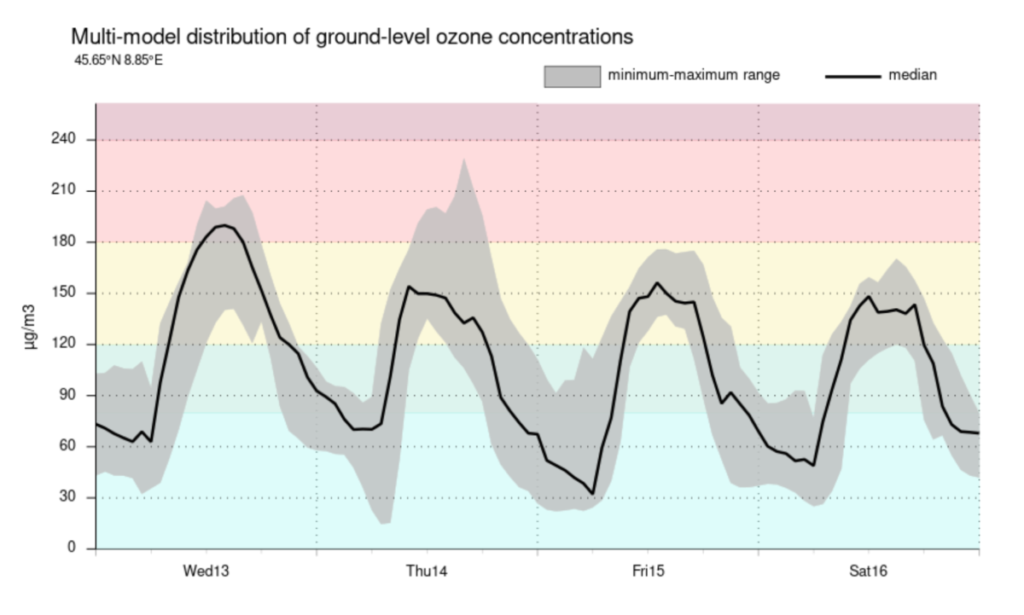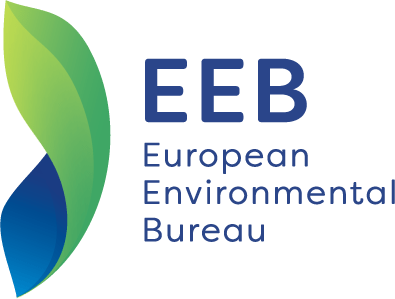Ozone onslaught across Southern Europe continues with six alarm threshold spikes already this year
Italy has experienced six spikes in dangerous ground-level ozone pollution this year, as levels reached beyond the 240 mg/m3 alarm threshold [1] with devasting consequences for human and environmental health warns civil society. While ozone levels regularly breach EU air quality standards (anything above 120 mg/m3), the alarm threshold has only been breached once in the past three years.
Exacerbated by heatwaves, similar peaks have been recorded across Southern Europe, yet civil society warn that little is being done at EU and national level to address one of the main precursors of ozone: methane, a powerful greenhouse gas. This week’s soaring temperatures have led to the latest example of levels exceeding EU air quality standards.

Ground-level ozone forecast (45.6°N, 8.9°E) 13-16 August 2025, from The Copernicus Programme [2]
Luc Powell, Senior Policy Officer for Air Quality and Agriculture at the European Environmental Bureau, said: “The EU is allowing ozone concentrations to reach dangerous levels regularly by failing to regulate methane alongside other precursors. The time to act on methane is now, we can no longer tolerate the devastating impacts on human and environmental health, including crops, and the climate. We need binding reduction targets, better monitoring and law enforcement, and support for farmers in the transition to practices that protect nature, people and the climate.”
Damiano Di Simine, Scientific Officer, Legambiente Lombardia, said: “The Po Valley is a hot spot of pollution and greenhouse gas emissions resulting from agricultural practices that have focused entirely on excessive livestock intensification and specialised monoculture. Incremental improvements in agricultural practices can reduce damage to the climate and human health, but they will not be decisive measures if the current framework of industrial agriculture is not changed.”
Marta Orihuel, Campaign Officer, Ecologistas en Acción, said: “The year 2024 was the third warmest in Spain since at least 1961. Intense summer heat, especially during the July and August heatwaves, have contributed to higher ozone levels and climate change is a key driver behind worsening air quality episodes. Agriculture accounts for 62% of methane emissions, highlighting the importance of the sector’s emissions, and the high concentration of industrial livestock farms in Spain is worsening air pollution and locally degrading water, soil, and biodiversity.”
Opportunities to act
The current review of the National Emissions reduction Commitments (NEC) Directive [6] and revision of the Gothenburg Protocol, which mirrors the NEC Directive at UNECE level [7] present a golden opportunity to set methane reduction targets and push for coordinated action within and beyond the EU to secure health, environmental and climate protection.
Action in the agri-food sector is vital and while the sector’s emissions are on the policy radar – evident in ongoing discussions [9] on pricing of agricultural emissions, and greenhouse gas targets for value chains – environmental groups urge policymakers to build robust policies that support the transition to sustainable agroecological practices with: reduced farmed animal numbers and density; improved manure and forage management; and better irrigation management in rice paddies to reduce methane emissions and regional ozone spikes.
ENDS
Notes to editors
[1] Insights on ozone pollution in the Pho Valley from Legambiente
[2] Ground-level ozone forecast from The Copernicus Programme
[3] European Environment Agency (2023): Harm to human health from air pollution in Europe: burden of disease.
[4] “Methane, climate change and air quality in Europe: exploring the connections”, briefing published by the European Environment Agency on 27 February 2025.
[5] In 2021, the EU signed the Global Methane Pledge, committing to reduce methane emissions by 30% by 2030 compared to 2020 levels. The voluntary agreement was signed by 160 countries. [6] The National Emission reduction Commitments Directive sets national emission reduction commitments for Member States and the EU for five important air pollutants but does not currently include methane.
[7] The Protocol to Abate Acidification, Eutrophication and Ground-level Ozone (also known as the Gothenberg Protocol) establishes national emission ceilings for four pollutants but does not include methane.
[8] The fourth objective of the Common Agricultural Policy (CAP) is to “contribute to climate change mitigation and adaptation”, which includes methane emissions. Yet, current CAP tools, notably eco-schemes, do not address methane directly. One opportunity is to support the transition to extensive livestock grazing, which could be strengthened by expanding environmental incentive measures both in the current CAP and in the next reform. This would help cut methane emissions while boosting environmental, health & animal welfare outcomes.
[9] Putting a price on agricultural emissions: EEB position paper outlines the potential design and scope of an EU Emissions Trading System for agriculture (agri ETS)

